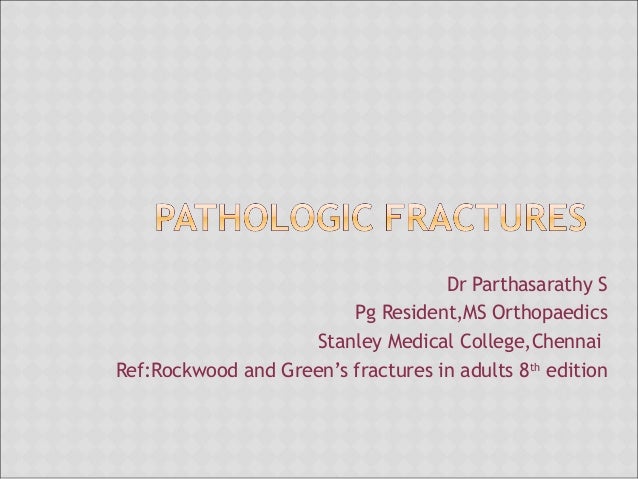

A CT chest and abdomen including a nuclear medicine bone scan was performed to stage the patient and assess for the presence of metastases. Skeletal traction was avoided to minimise septic complications.ĭuring their admission, an MRI scan of the entire involved femur was done to assess the site and size of the lesion, its proximity to neurovascular structures, and to exclude skip and satellite lesions.

Treatment of pathological fracture skin#
The patients were admitted and treated with bed rest and skin traction until fracture union.
Treatment of pathological fracture series#
We performed a retrospective review of a series of six patients referred to our unit with pathological fractures from 2009 to 2014. This treatment results in comparable survival rates to amputation with the advantages of a cosmetically and functionally superior limb. 4,6-8 More recent studies have shown that careful selection of patients, initial immobilisation, and neo-adjuvant chemotherapy where indicated, leads to fracture healing and facilitates adequate resection of margins subsequently. 1-5 It was previously thought that this problem should be treated with amputation to prevent local recurrence, reduce incidence of metastases and improve survival. Primary bone sarcomas that are associated with a pathological fracture ( Figures 1-4) are rare and as a group have a worse prognosis than their non-fractured counterparts. Key words: pathological fracture, sarcoma, limb salvage, endoprosthetic replacement Endoprosthetic replacement allows for rapid reconstruction and mobilisation in this group of patients facilitating further oncological management. One patient died of a myocardial infarction post-operatively, and two patients developed lung metastases and died 2 years later.ĬONCLUSION: Our conclusion is that with careful planning, a safe margin can be achieved. Due to the aggressive nature of these types of tumours they carry a worse long-term prognosis and as such we had three deaths in our series. Our results show 100% of patients had clear margins at postoperative histology. Three patients required total femur resection due to extensive tumour involvement. All had distal femur involvement with a 60% incidence of osteosarcoma and 40% chondrosarcoma. RESULTS: The age range of our series is from 20 to 81 years, with four males and two females. These were treated by initial traction and neo-adjuvant chemotherapy where indicated with subsequent resection and endoprosthetic replacement. PATIENTS AND METHODS: We present a retrospective review of a series of six patients referred to our unit with pathological fractures. QUESTIONS/PURPOSES: Traditionally limb ablation was advised however, recent evidence suggests that limb salvage is a safe and acceptable form of treatment for both surgeon and patient. IIMBChB(UCT), FCOrth(SA) Vincent Pallotti Life Orthopaedic Hospital, and Princess Alice Orthopaedic Unit, Groote Schuur Hospital, University of Cape TownīACKGROUND: Primary bone sarcomas that are associated with a pathological fracture are rare and as a group have a worse prognosis than their non-fractured counterparts. IMBChB(UCT), DA(SA), DipPEC(SA), FCS(Orth), MMed(UCT) Vincent Pallotti Life Orthopaedic Hospital, and Princess Alice Orthopaedic Unit, Groote Schuur Hospital, University of Cape Town Endoprosthetic treatment of primary bone sarcomas with pathological fracturesĭr Thomas I L Hilton I Dr Keith Hosking II


 0 kommentar(er)
0 kommentar(er)
